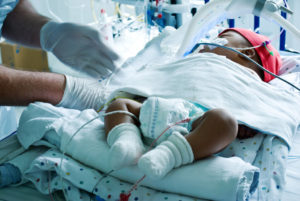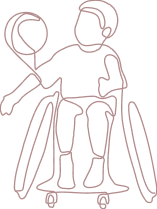What is hypoxic-ischemic encephalopathy?
HIE is a brain injury that can occur before, during, or after childbirth. It happens when the normal supply of oxygen and blood is cut off to a baby’s brain for a period of time.
 When blood flow decreases, the amount of oxygen and glucose (sugars) also decreases. At the same time, calcium levels increase, which causes brain cells to die.
When blood flow decreases, the amount of oxygen and glucose (sugars) also decreases. At the same time, calcium levels increase, which causes brain cells to die.
The extent of the damage depends on how long the brain’s oxygen supply is cut off. Just 5 minutes without oxygen can cause a child to suffer permanent intellectual disabilities and developmental delays.
HIE can affect other organs as well, including the heart, kidneys, and lungs.
To better understand HIE, it helps to break down what each word means:
- Hypoxic – not enough oxygen
- Ischemic – not enough blood flow
- Encephalopathy – brain disorder
HIE is a type of birth injury that is sometimes also referred to as birth asphyxia, perinatal asphyxia, or neonatal encephalopathy. Asphyxia is a term used when there is a lack of oxygen.
Hypoxic ischemic encephalopathy is one of the most common causes of death and long-term disability in neonates (newborns).
Talk to a nurse for free today to get answers about your child’s HIE and learn what resources are available to help your family.
Hypoxic ischemic encephalopathy causes
Various issues during pregnancy, labor and delivery, and the postnatal period (after birth) can lead to infant hypoxic-ischemic encephalopathy.
- During pregnancy:
- Drug or alcohol abuse
- Fetal anemia (low blood count)
- High blood pressure (preeclampsia)
- Infection passed from the mother to the fetus
- Lesion (mass) in one of the baby’s lungs
- Maternal diabetes
- Placenta detaching from the inner wall of the uterus
- Uterine rupture (can also happen during active labor)
- During labor and delivery:
- Abnormal fetal position, such as a breech birth
- Bleeding from the placenta
- Maternal low blood pressure
- Prolonged labor, especially in cases where the baby is larger
- Ruptured placenta
- Umbilical cord accidents
- After birth:
- Brain or skull trauma
- Extreme prematurity (born before 28 weeks)
- Infection, especially meningitis and sepsis
- Low blood pressure
- Severe heart or lung disease
HIE can also be caused by medical negligence, such as when a doctor improperly treats a mother’s high blood pressure during pregnancy or fails to notice signs of fetal distress, like increased heart rate.
Hypoxic-ischemic encephalopathy symptoms
HIE symptoms do not always appear immediately, so it’s important for parents and medical professionals to monitor babies closely after birth for signs of oxygen deprivation.
HIE symptoms may include:
- Breathing problems
- Decreased alertness
- Dilated pupils
- Feeding problems
- Floppy or weak muscle tone
- Irregular heartbeat
- Irritability
- Movement abnormalities
- Pale/blue skin or lips
- Seizures
- Slow or absent reflexes
- Weak cry
Parents should seek immediate medical care if a child shows any of the above signs of HIE.
Infants with HIE may also have a low Apgar score. Apgar is a test given to babies soon after birth. A medical professional examines the baby’s breathing, heart rate, muscle tone, reflexes, and skin color and scores each category from 0 to 2.
An Apgar score lower than 7 is a sign that the baby needs medical attention.
Hypoxic-ischemic encephalopathy diagnosis
If your medical team thinks your baby has HIE, they will usually use a combination of clinical, imaging, and laboratory tests to diagnose the condition.
Tests used to diagnose HIE include:
- Computerized tomography (CT) scan: X-rays are used to take multiple images of the skull that are then stacked together to create a 3-D image of the brain’s structures.
- Electrocardiogram (ECG or EKG): Electrodes measure electrical activity in the baby’s heart and detect any irregularities that may have caused HIE.
- Electroencephalography (EEG): Electrodes are placed on the scalp to check the brain’s electrical activity and determine if the baby has had any seizures.
- Magnetic resonance imaging (MRI): 3-D images are taken of the baby’s skull to look for areas with brain damage. MRI is the most accurate neuroimaging test for diagnosing HIE.
- Ultrasound: Sound waves are used to create a picture of the baby’s brain so doctors can see how badly the tissues are damaged.
- Umbilical cord blood gas test: Blood is drawn from the baby’s umbilical cord artery to check for signs of acidosis (a buildup of acid), which can be a sign the baby was in distress prior to birth.
The doctor may also order tests to see if other organs like the heart or kidneys were affected from the lack of blood flow and oxygen.
Was your child diagnosed with HIE? Get a free case review now to see if you qualify for financial assistance to help with their care and treatment.
Hypoxic-ischemic encephalopathy treatment
Treatment for HIE depends on the stage of the brain injury and the symptoms the baby is experiencing.
Cases of mild HIE may resolve. Doctors will monitor the infant closely to make sure they’re stable before discharging them from the hospital.
Babies with moderate or severe HIE will require immediate brain cooling, but other therapies may be used as well.
Brain cooling
The only method that’s been proven to reduce the extent of brain injury in babies with HIE is therapeutic hypothermia treatment. Therapeutic hypothermia is performed either through brain cooling or whole-body cooling.
Therapeutic hypothermia must be started within 6 hours after birth. The baby will be given a cooling cap or placed on a cooling mattress for three days to lower their body temperature. This helps slow the death of brain cells and prevent toxic substances from forming in the brain. It also reduces the risk of increased calcium to the brain.
The baby will be given medicine to help them rest. While they rest, the medical team may perform tests to monitor the baby’s brain activity and determine if the treatment is working.
Other treatment options
Along with brain cooling, other steps may be taken if any organ dysfunction occurred from the lack of blood and oxygen.
Some of these additional measures include:
- Administering anti-seizure medication
- Closely monitoring the heart and kidneys
- Inserting a breathing tube if the baby can’t breathe on their own
- Stabilizing the baby’s blood pressure
As the baby grows, doctors may recommend physical, occupational, or speech therapy to help treat long-term disabilities caused by HIE.
Hypoxic ischemic encephalopathy prognosis
The prognosis for HIE depends on how long the baby’s brain was deprived of oxygen. Infants with mild cases of HIE (minimal time without oxygen) may recover with little to no disabilities.


It can take years for the effects of HIE to emerge. A child’s frontal lobe typically doesn't start to develop until age 10. At this point, parents may begin to notice behavioral changes in their child, such as aggression, anger, or frustration.
Hypoxic-ischemic encephalopathy in adults
Babies diagnosed with HIE may suffer from long-term health problems and behavioral issues if they have permanent brain damage.
While some children only experience mild to moderate effects, others may develop serious complications that are quite expensive to treat and may affect them well into adulthood.
For example, a child with HIE may develop cerebral palsy, which is a lifelong movement disorder with no cure.
Some healthy adults can develop HIE from a heart attack or traumatic head injury. Generally, any medical event that damages blood vessels in the brain can cause hypoxic-ischemic encephalopathy in adults.
Hypoxic ischemic encephalopathy stages
The system used to classify HIE stages is known as the Sarnat grading scale. There are three Sarnat stages, and the specific stage depends on the baby’s alertness, muscle tone, pupils, respiration, seizure activity (if any), and duration of symptoms.
The three stages are:
- Stage 1: Mild HIE
- Stage 2: Moderate HIE
- Stage 3: Severe HIE
The longer the baby’s brain goes without oxygen, the greater the chance they will suffer from moderate or severe HIE.
Sadly, between 25-75% of babies who have moderate HIE will develop serious impairments or possibly die early in life.
Getting help for infant hypoxic-ischemic encephalopathy
The effects of HIE are devastating to many families. Brain damage from HIE can cause children to develop lifelong disabilities that limit their quality of life and put tremendous stress on their loved ones.
It’s critical to connect with a birth injury lawyer if your baby was diagnosed with HIE. One mistake made by a doctor or other health care professional can change a child’s life forever.
Compensation from a birth injury lawsuit can provide financial and emotional relief to families affected by HIE caused by medical negligence.
Get a free case review now to learn more about your legal rights.




